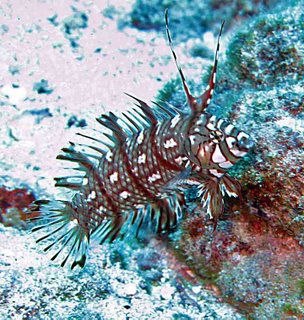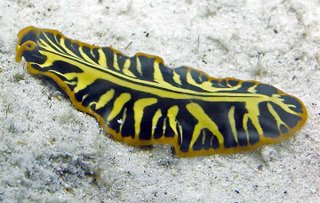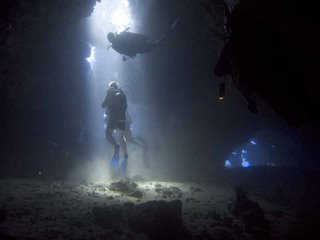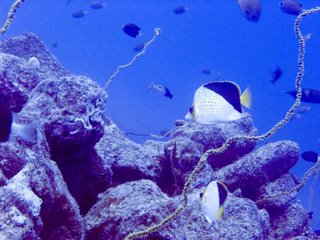
Here's a couple photos Pat took the other day of a rather large Commerson's Frogfish (Antennarius commersoni). Pat figured it was roughly basketball sized. For those of you not familiar with frogfish, they are a member of the angler family. Frogfish will basically sit motionless on a rock and wiggle a small appendage above their mouth which acts as a lure for small fish. They have a hinging jaw and they can gulp down any small fish that approaches, some frogfish are capable of eating fish as large or larger than themselves. Frogfish are also known to be the fastest eaters on the planet, according to the website of the Shedd Aquarium, they can swallow their victim in 6 milliseconds !!!! That's faster than I can eat a Burger King whopper.
These guys start off bright yellow, and as they grow they tend to slowly get multicolored ugly (is that a color?) to match their surroundings. You may even have to look twice to see it in the photos, they can be real hard for divers to spot... I believe Bob swam right past this one and only one of the divers in the group noticed it at first. I have a couple of pictures of a medium sized frogfish back in the blog (check the archives) which had lost it's yellow and yet to develop the other colors. Pat's flash didn't fire on these shots, so the pictures have had some photoshop help, but they should be relatively close.

Yesterday I dove with another operator. Most of the dive operators here are "friendly competitors" and you will often find crew members who work for several operators. I'll help out from time to time when someone's in a pinch and I'm not already commited. I've got several dive operators I recommend when I can't service someone's needs (full boat, too big of a group, etc), if you are thinking of diving Kona, do check with me for reservations... if I can't take care of you myself, I'll be happy to recommend someone who might have availability.
I'm still waiting on my Camera, I think it was shipped on Monday or Tuesday. I played with Ebay for the first time ever and picked up an underwater housing for an Olympus flash unit, direct from Olympusauctions, for dirt cheap. For the camera or camera housing, you probably can do just as well or better off Amazon than you can off Ebay, but the housing for the flash is a low demand item and I managed to pick up a new, in the box, $300 buck housing for $58... now I have to buy the flash... uggh, the camera hobby can be expensive. I've always used just the camera's onboard flash, or forgone a flash alltogether before. Since the housing for the remote flash was available so cheap, I figured it might be worth the investment. Once it all comes in I'm still going to have to deal with a tray, arms and maybe a focus light... I hope people take me up on the underwater digital camera rental when this is all said and done.
later,
Steve






